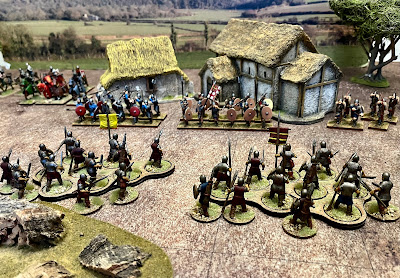Earlier this year, I started to paint a box of Fireforge Almughavars. After painting 12, the remainder sat in the to-do box until the New Year holiday when I decided to finish the job. Fireforge offers a box of 24 plastic figures with an extensive range of optional heads and weapons. The faces could do with more definition, but otherwise, they are very nice sculpts. I am not a big fan of assembling figures, but these fit together well with plastic glue.
A former Templar and pirate, Roger de Flor, founded the Catalan Grand Company in 1302. They had been fighting against the Angevins in Sicily and were hired by the Byzantines to fight the Turks. The company initially consisted of around 1,500 horse and 4,000 Almughavar infantry. They defeated the Turks in Anatolia and were recalled to the Balkans to defeat the Bulgarians.
After they were reinforced from Spain, the Emperor became concerned about their power and arranged for Roger de Flor to be assassinated. The Byzantines attacked the remaining troops, but the Catalans regrouped and defeated them at Apros in 1305. The company then devastated Thrace and Macedonia in what became known as the Catalan Vengeance. Next, they were hired by the Duchy of Athens, which failed to pay them, so they attacked and defeated the Duchy at Kephissos in 1311. After that, they held and expanded the Duchy of Athens until they were defeated by the Florentines in 1388.
They built the army around a core of Almughavars. Originally Aragonese hillmen from the Pyrenees, they would have included veterans from many different peoples across Spain and the Balkans by this period. They were particularly effective at utilising rugged terrain - supported by knights, allied light horse and Greek archers.
Almughavars are particularly difficult to classify in wargame armies. In the To the Strongest army list I wrote, we agreed on Javelinmen with a special rule replacing one javelin with a shock missile to give them more punch. In Lion Rampant, I went for the Warrior classification, which allows them to fight in rough terrain and be effective in combat. The problem is the lack of armour, which, as you can see from the models, they certainly had, and no shooting with javelins. ADLG goes for Medium spearmen impact, which is another compromise. The fundamental problem is that they had a variety of capabilities, which is difficult to pigeonhole in one classification.
Catalan knights are like any other of the period. However, Lion Rampant has a helpful upgrade called Motivated, which allows easier standard moves because the unit has less of a snooty attitude to the grunt work of small-scale battles. Mercenaries don’t generally do snooty! The lighter cavalry has a similar problem to the Almughavars. They were javelin armed but were quite happy to get stuck into hand-to-hand combat. This reminds me of Numidians, that are also difficult to classify for the same reason.





Wow - another book I’ve read (Lowe’s The Catalan Vengeance). That must have been 40+ years ago.
ReplyDeleteAmazon tells me the Lowe book was published in 1972, but I suspect I wouldn’t have read it till I’d left school and got a job … to be able to afford to buy more books than mere pocket money would allow.
The impression I had/have of the Almughavars is that they were desperate, hard-fighting vicious men - not the sorts that you would want to fight in close combat. They seemingly lacked much in terms of armour and shields, so they needed to get into close combat as quickly as possible - whether that was a swift assault on the enemy, or to lure the enemy into a rash charge in unfavourable terrain.
Cheers,
Geoff
I'd forgotten it was that old. I picked it up second hand some years ago, but not that long. That was my impression, given they were originally hillmen. However, the models have quite a bit of chainmail armour. I suspect it reflects captured gear, and they recruited locally. As I say, tricky to classify without turning them into super troops.
ReplyDelete